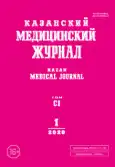Features of social and hygienic factors of young primiparаs
- Authors: Shchetinina NA1, Lavlinskaya LI1, Lavlinskaya TA1, Chernykh EA1
-
Affiliations:
- Voronezh State Medical University named after N.N. Burdenko
- Issue: Vol 101, No 1 (2020)
- Pages: 80-83
- Section: Social hygiene and healthcare management
- URL: https://ogarev-online.ru/kazanmedj/article/view/19444
- DOI: https://doi.org/10.17816/KMJ2020-80
- ID: 19444
Cite item
Full Text
Abstract
Aim. To assess the health status of young primiparae by studying the basic social and hygienic and demographic factors.
Methods. The study involved 48 female patients of the women's consultation office registered with the pregnancy. The age ranged from 12 to 17 years, and averaged 15.7±1.4 years. We distinguished three clusters allowing to divide young primiparae into study groups: young — 12–13 years (n=15; 31.2%), middle — 14–15 years (n=20; 41.7%) and senior — 16–17 years old (n=13; 27.1%). The gestational age of young primiparae averaged 12.3±4.5 weeks. We conducted an anonymous survey of young primiparae, which included questions regarding the social hygienic and demographic factors of pregnancy. Differences were considered significant at a confidence level of p ≤0.05.
Results. Most primiparae were raised in single-parent families (n=36; 75%), while in the young cluster, this social factor was identified among almost all girls (n=14; 93.3%). 30 young primiparae had random sexual activity (62.5%), the most pronounced indicator was found in the senior cluster (n=10; 76.9%). Assessment of social economic factor of primiparae taking into account the living conditions, found that 21 (43.8%) of them lived in a rented apartment. None of the primiparae from a young cluster lived in her own apartment or house. Most of the respondents were not satisfied with their living conditions (n=37; 77.1%). Evaluation of social economic factor of primiparae taking into account the income revealed that low income per family member of young primiparae amounted to 33.3% (n=16). In the young cluster, material income was low in most cases (60%).
Conclusion. Young primiparae aged 12–13 years have the most pronounced adverse sociohygienic and demographic factors of early pregnancy in contrast to older age groups.
Full Text
##article.viewOnOriginalSite##About the authors
N A Shchetinina
Voronezh State Medical University named after N.N. Burdenko
Author for correspondence.
Email: Shchetinina.2016@inbox.ru
Russian Federation, Voronezh, Russia
L I Lavlinskaya
Voronezh State Medical University named after N.N. Burdenko
Email: Shchetinina.2016@inbox.ru
Russian Federation, Voronezh, Russia
T A Lavlinskaya
Voronezh State Medical University named after N.N. Burdenko
Email: Shchetinina.2016@inbox.ru
Russian Federation, Voronezh, Russia
E A Chernykh
Voronezh State Medical University named after N.N. Burdenko
Email: Shchetinina.2016@inbox.ru
Russian Federation, Voronezh, Russia
References
- Sibirskaya E.V., Bogdanova E.A. Pregnancy and labor course in very young primaparae. Reproduktivnoe zdorov'e detey i podrostkov. 2012 (2): 12–31 (In Russ.)
- Vasil’eva L.N., Kuzmich N.V., Kolysko D.V. Characterization of pregnancy and its outcomes in young primiparae. Molodoy uchenyy. 2017; (44): 45–48. (In Russ.)
- Kulakov V.I., Dolzhenko I.S. The main trends in the reproductive health of girls in modern conditions. Reproduktivnoe zdorov'e detey i podrostkov. 2005; (1): 22–26. (In Russ.)
- Adamyan L.V., Koltunov I.E., Petryaykina E.E. Pregnancy and childbirth in young primiparae, dangers and how to overcome them. Moskovskaya meditsina. 2016; 3 (1S): 67–68. (In Russ.)
- Mikhaylin E.S. Features of the course of pregnancy and childbirth in minors and women of middle reproductive age. Mezhdunarodnyy zhurnal eksperimental'nogo obrazovaniya. 2014; (8): 145–146. (In Russ.)
- Kiselevich M.F., Kiselevich V.M. Features of a current of pregnancy and child birth at young primapara women. Nauchnye vedomosti Belgorodskogo gosudarstvennogo universiteta. Seriya: Meditsina. Farmatsiya. 2010; (10): 58–61. (In Russ.)
- Vasil’eva L.N. Pregnancy and childbirth in adolescents: a look at the problem. Meditsinskiy zhurnal. 2010; (3): 139–140. (In Russ.)
- Sitnikova L.N., Lavlinskaya L.I. Organization of medical care for pregnant high-risk groups. Vestnik novykh meditsinskikh tekhnologiy. 2014; (1): 65. (In Russ.)
- Sitnikova L.N., Lavlinskaya L.I. Reproductive behavior of students of a medical university. Materials of the All-Russian Conference with international participation dedicated to the 90th anniversary of the Department of Public Health and Health. Health economics. 2014; 193–194. (In Russ.)
- Dokuchaeva O.Yu., Lavlinskaya L.I., Schetinirna N.A. Medical and social aspects of in vitro fertilization. Molodezhnyy innovatsionnyy vestnik. 2016; 5 (1): 459–460. (In Russ.)
- Lavlinskaya L.I., Lavlinskaya T.A., Shchetinina N.A. Socio-hygienic characteristics of age and primipara young primipara. Mezhdunarodnyy nauchno-issledovatel'skiy zhurnal. 2016; (8): 103–105. (In Russ.)
- Nikolaeva L.B., Ushakova G.A. Socio-hygienic and biomedical characteristics of primiparae of different reproductive age. Mat' i ditya v Kuzbasse. 2013; (3): 43–50. (In Russ.)
- Kalinina O.I., Lavlinskaya L.I., Lavlinskaya T.A. Organization of medical care for young primogenous women. Molodezhnyy innovatsionnyy vestnik. 2016; 5 (1): 468–469. (In Russ.)
Supplementary files






